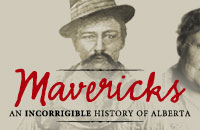 |

[ Project Plans | Essential
Questions | Knowledge Hunt | Glossary | Links ]
Canadian Conflicts Heritage Minutes
Creating "Heritage Minutes" to Understand How War
Changed and Shaped the Canadian Identity
Introduction
Students need to critically examine how major events, such as war
and conflict, changed the way of life in Canada and appreciate the
impact of these changes on citizenship and identity. What do the
stories of these Mavericks tell us about the development of Western
Canada? What was it like to live through wartime? Why was Alberta
an important part of the home front during wartime? How did Albertans
contribute to the Canadian war effort?
Project Explanation
In this project, students will develop an appreciation of how war
helped to develop the identity and heritage of the province of Alberta.
They will choose a topic for a short presentation modeled after
the "Canadian Heritage Minute" commercials on television.
They will research the Maverick and the conflict, plan and script
their presentation, and practice the production. The students will
then assemble it into a finished presentation by gathering props,
finding costumes, using accents and speech mannerisms, and record
the practiced scenes. The presentations can then be shared with
the entire class.
Alberta Social Studies Curriculum Unit Connections
Grade Four - Alberta: The Land, Histories and Stories
4.2 The Stories, Histories and People of Alberta
Grade Five - Canada: The Land, Histories and Stories
5.2 Histories and Stories of Ways of Life in Canada
Materials and Resources Needed
Procedures
Students will create a "Heritage Minute," modeled after
the Canadian Heritage television commercials promoting Canadian
history. Students will research one of the "War and the Home
front" Mavericks from the Mavericks: An Incorrigible History
of Alberta site, picking one small "vignette" from
that person's life to explore and dramatize. The final product
may be done as a live dramatic presentation, a digital video production,
or even a photographic slideshow using a program like PowerPoint,
depending on how the teacher wants to approach the project and the
technology available.
Teachers may introduce the project by going to the Canadian Heritage
Minutes website. All of the Heritage Minutes are collected there,
with background information and an online video of the commercial
itself. Viewing a number of the videos will give students an idea
of what they are attempting to create. They will need to make a
presentation to assist others to learn about a part of one of the
Maverick's life, that is of high interest, and is historically
accurate. How did that Maverick represent Canada? Why are they respected?
Why were they chosen as a Maverick?
Students will begin by choosing the topic of the Heritage Minute
and creating the background information section for their presentation.
They will have to choose a Maverick to focus on, find a specific
event to dramatize, and then research all pertinent information
needed as background information by their audience. They will need
information about the person, what their job was, their personal
history, and the war(s) they participated in.
Once they have the information, they will have to write the actual
background information document that will go with their Heritage
Minute. They should include information on who the person was, what
their accomplishments were, and how they benefited the war effort.
Once the research and background information is complete, they
can begin scripting and storyboarding their Heritage Minute. One
minute is not a lot of time, so they will have to remember to be
concise in their use of language and content. They will also have
to decide on any costumes or props needed and how or where they
will create the backdrop for their scene.
The students will need time to practice their scenes, even if filming
the Heritage Minute, as this will speed up the process once they
are in front of the camera. They will then either be ready to present
live in front of the class or to film and edit their Heritage Minutes.
If creating a digital video or PowerPoint, they may add narration,
sound, music, titles and subtitles to their presentations. Once
the presentations are edited and finished, they may be presented
in class to their peers.
Assessment and Evaluation
- After the teacher and students collaboratively create a rubric,
students should use it as a guide for their learning as they are
working through the process, regularly checking that all the needed
elements are included in their work and revising as needed. The
rubric can then be used as a formal evaluative tool when they
have completed their project.
- Students may evaluate themselves and their peers using their
project rubric, examining each other's project for historical
accuracy, detail, and creativity.
- A project journal may be used for information gathering as well
as for reflective writing as the process is taking place. Students
can pose questions, vent frustrations, synthesize their work,
examine their process, and even wonder about what they are missing
or what is still needed for their project. This may be completed
as a group or individually.
- Students should use their journal to reflect upon their group
dynamics, how the problem solving process worked, their solutions
to the problem, what could have been done differently or better,
and any successes or frustrations they felt when working with
their group.
Ideas for Enriching this Project
- Students may plan and organize a special "Red Carpet Movie
Premiere" to show off the their work for the parents.
- Students could create a web page for each Heritage Minute, including
a scaled down version of the digital video or PowerPoint, as well
as their Background Information section.
 |



![]()
